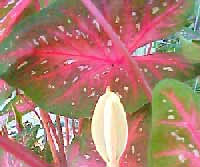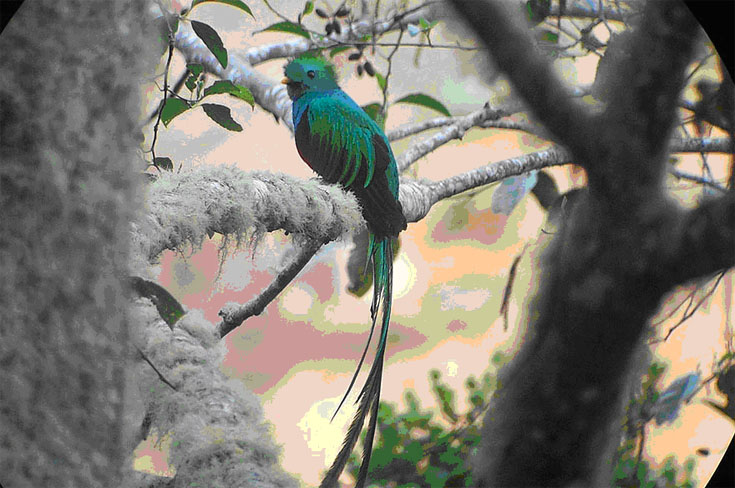|
|---|
One of the Colorful Costa Rican Jungle Birds - The Resplendent Quetzel |
Broken News
Munching Pejibaye
You get 100 points if you can even pronounce "pejibaye" the first time. It's pronounced peh-hee-buy-yay. This is yet another product of a palm tree.
 |
|---|
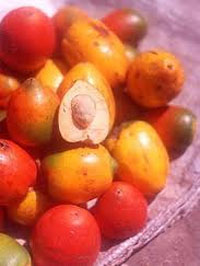 |
Pejibaye on the Palm Tree (top) & Picked Fruit (lower) |
My first introduction to pejibaye was on a bus from San José to Quepos about six years ago. The driver suddenly stopped the bus on the side of the road, i.e., the old two-lane, narrow winding mountain road that went through Atenas. What stopped him? There was a vendor friend on the side of the road he wanted to talk to. He put the emergency break on, left the bus running, got off and bought two bunches of pejibaye. (There are some things just as important as bus safety on a mountain road)
This sort-of fruit-come-vegetable, is undoubtedly one of the strangest in Costa Rica. It is picked green, orange or bright red. The fruit eaten raw has the consistency of compressed sawdust high in wood fiber and tastes about the same (sorry, but that's what it tastes like to me). After boiling the fruit whole,. the fibers get a little softer. Ticos eat them split open, nut removed with maybe a dollop of mayonnaise or hot sauce.
The bus driver couldn't wait until he got the bunches home so he started nibbling a piece or two of the fruit raw, whilst he drove one-handed over the mountain road. He did, however, hold the rest of his cell phone calls until we got to the straightaway. (I love living on the edge)
As often reported in these pages, Ticos like fiestas and, of course, there is a festival just for pejibayes. This year it took place over two weekends in October in a town called Tucurrique, east of the town of Cartago and a bit south of San José. This was the 19th annual festival and it drew about 25,000 pejibaye lovers. GG's crammed social schedule prevented his attendance.
There was mucho entertainment at the festival including several runnings of the bulls. This is not like Spain, they don't run through the streets, the bulls just get taunted mercilessly by young tico lads, a considerable portion of whom are inebriated. It's done in an arena and is lots of fun to watch (see Bull) as the bulls are continuously frustrated by the Ticos running around them yelling and making faces (they did that to me also when I was growing up).
Virtually all the Ticos escape injury as they dive behind barricades when the bull comes their way and no harm comes to the bulls except the distinct possibility that some of them (the bulls) may need counseling after the event.
¡Ole and Pura Vida!
As expected after his invasion last year. Danny Ortega, the Nicaraguan president and conqueror of Isla Calero in northern Costa Rica, is going forward with his plans to build a major canal across Nicaragua connecting Atlantic and Pacific Oceans.
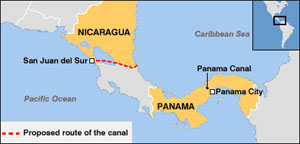 |
|---|
Canals to the North of Us, Canals to the South of Us |
The route chosen for the new canal is the same as one proposed as an alternative to the original Panama Canal. It begins on the Atlantic side near Isla Calero (funny how that worked out) and will run along the San Juan river that serves as a border between Costa Rica and Nicaragua, then across broad lake Nicaragua and then will exit near San Juan del Sur on the Pacific coast.
All for only $30 billion, at least that's the original estimate. How does a country with a national budget of about $1.5 billion and GDP of $6.5 billion (vs Costa Rica at $13/$36 billion and the U.S. at $3,600/$14,600 billion) build a $30 billion canal or even convince an investor that they can pay back such a loan? Nope, can't do it on their own, can they?
 |
|---|
 |
Danny and Chavez Having a Love-In (Top). Below, Holding Hands With His Good Friend, Iran's Ahmadinejad |
But wait, Danny Ortega has built relationships and can rely on some very long term, low interest loans (or grants) from friends (Danny's Friends) like Venezuela's Hugo Chavez and Iran's Ahmadinejad. Further evidence of the chicanery afoot was given in recent days when it was reported that "Nicaragua’s legislature has approved a bill authorizing construction of an oil refinery, an inter-oceanic pipeline and other facilities, a $6.6 billion project to be partially funded by close ally Venezuela."
So who's capable of and likely to build the ditch? China, of course. Señor Ortega recently issued the following announcement:
“I want to communicate to the Nicaraguan people, to the Nicaraguan families, that this very afternoon we signed a memorandum of agreement in which the State of Nicaragua, through its representative, the president of the Canal Authority, authorizes the company HK-Nicaragua to manage the financing of the project for the inter-ocean canal in Nicaragua” and he explained that "... the Chinese company, Investment Company for the Development of the Great Nicaraguan Canal, will work to develop the canal that will connect Pacific Ocean with the Atlantic Ocean, starting in Monkey Point and ending in Puerto Corinto."
So the point is that the monkeys of Monkey Point are gearing up for a new canal. There's sure to be more revealed in the coming months, stay tuned.
Hollywood and Vine
Will wonders never cease. San José, after 10 years in the planning (don't ask; I don't have the answer why, except maybe "Tico Time"), San José is now installing street signs.
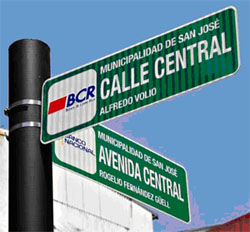 |
|---|
Hollywood and Vine - San José |
It will take some time to complete the installation as there are almost 7,000 plates that are planned for pole placement as well as another 9,000 for buildings and walls.
The intersection pictured to the left might be thought of as the geographical center of the city one would find on a GPS map. Calle Central and Avenida Central are SJ's equivalent of Los Angeles' Hollywood and Vine or maybe Manhattan's 52nd Street and 5th Ave.
Of course, let's not go the whole schmear and number the houses and buildings at the same time. Supposedly, numbers, or specific addresses actually do exist but no one knows them, least of all taxistas or even the post office, so they're not used. If the signs at the left are true, there is not even a sub entry for the block, for example: "Avenida 1 - (1,700) Block".
It appears at best that one will have to give a taxi driver is the intersection of the Calle and the Avenida in order to get close to the destination. My guess is it will be a long time, like maybe a whole generation, before cabbies will be even able to navigate by intersections, the old timers holding out for a location fix by landmark. If today you said to a taxista you wanted to go to Avenida Segundo and Calle Cinco (second Avenue and Fifth Street) most cabbies would ask you to explain further, but if you said "La Caja, por favor", bingo you'd get there pronto as everybody knows that the Health Ministry, or "La Caja", is situated on that corner.
Another complication is the way the streets were originally laid out. The avenues run east and west but are numbered from Central Avenue going south as Avenida 2, Avenida 4, Avenida 6 etc, while going north they're Avenida 3, Avenida 5 and so forth. The streets are similarly numbered, going 3, 5, 7 etc; going east and the even numbers going west. This assures that they'll never be a 400 block of Avenida 2 or a 700 block of Calle 7. All numbering will have to jump by 100 at the beginning of each block. Colorful, isn't it?
Will Quepos follow the capitol's lead? Not likely soon but, I suppose, eventually yes. In the meantime GG will continue to give his official Quepos street address, that which appears on the electric bill, as "50 meters east of Dr. Mojarro's Clinic, on the corner" and pray that UPS knows or can find out where Dr. Mojarro's Clinic is.
Not letting any jungle moss grow under his feet, the golden one already began naming the streets in Quepos back in November of 2010 - see When There is No Name.
Expat Amnesty
Now they tell me.
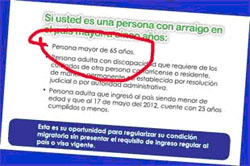 |
|---|
Paragraph in the New Law that Gives Expats Hope for Amnesty |
Costa Rica recently instituted an amnesty law that was primarily directed at illegal Nicaraguans here, of which there may be as many as 15% of the population or well over a half million. Now, one outfit that specializes in helping expats get residency here believes the same law might be applied for expats who happen to be over 65 years of age and have been living here illegally for at least five years.
Well, OK, right there; that disqualifies me as I've been living here only four years. And, anyway, I got my residency after only three and a half years.
But you have to read more in the new new code to find out it's not as easy as it sounds. You still have to go through the regular process like I did, You have to get a certified birth certificate, a clean police record and all the other documents, translations, fingerprints, photos ad nauseam. So this new policy doesn't do anything for me now nor would it have done anything for me before I got my cédula. It's aimed at the technically and seriously illegal.
The clean police record from home may still be the undoing of many of these illegals. There are a number of people I know here in Quepos who have not left Costa Rica in over five years, not even bothered to go to the border every 90 days to renew their visa as is required. They basically live a quiet life of a fugitive, being careful not to do anything that would attract the attention of the police or other government organizations. This new loophole may be right for them but I suspect a significant number of them may have trouble producing a clean police report.
As a friend of mine says: "Many people come to Costa Rica because thwy are unwanted back home, ... or maybe even wanted".
Rumble Talk
(Tidings of Tremors on the Pacific Rim)
I briefly reviewed the Chronicles over the last year and found that nearly every edition had something to say about a past, present or potentially future earthquake and their consequences. So I thought I would create this section, called Rumble Talk as a monthly update on various happenings related to the unstable world of living on the Pacific Rim in Costa Rica. I hope you enjoy them.
When the country escaped an earthquake calamity as reported in last month's Chronicle (see Terremoto Terror), the damage seemed slight, at least relatively speaking. Now more information is in and damage in many places was reported heavier than at first thought.
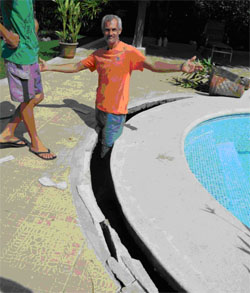 |
|---|
This Guy's Pool Was Summarily Widened About 10" in Ten Seconds |
The damage is extensive to both public and private property. Some of the more significant reports:
- a large hotel (Barcelo) in Tambor Beach, Nicoya had 150 rooms declared unsafe by the local authorities. When the hotel will be back in service is unknown.
- another resort suffered a collapsed wall and numerous sunken patios. They made repairs quickly at a cost of over a $100,000.
- many country roads became impassable because they split apart. The government is working its priorities to reopen them based on how critical the routes are to locals. Some of these roads are the only means of accessing certain towns and villages.
- the Puntarenas ferry to the Nicoya is back in business after being down for a week as the channel, which the quake had filled in some places, was dredged anew.
Last month it was reported that the Puntarenas Hospital would be permanently abandoned. This is the hospital where our hero happened to be when the big one hit. I visited there again on October 8 trying to complete the original appointment for a cataract exam that was interrupted by the tremor on September 5. On walking around the abandoned hospital on this latest visit, I engaged in conversation with two EMT's standing by their ambulances who told me that, after more extensive investigation, the authorities have decided to pursue repairs of the heavily damaged hospital which may take 1-2 years to complete.
I could find no confirmation that what the EMT's said has been announced by the government. Frankly, I don't think the authorities yet know if they can successfully repair the old building. In the meantime, President Chinchilla has obtained emergency funding to go ahead with the building of a second hospital in nearby Baranca. Of course, even on an expedited basis, that could take two years.
The loss of the hospital has caused what might be described as controlled chaos for its staff and services, all of which had to dispersed to any facility in the area capable of housing them. A temporary 100 bed "hospital" is being set up in a large warehouse previously used as a regional drug and medical supplies distribution center. The original hospital had 300 beds, so many of the more serious cases have had to be forwarded to hospitals in the central valley. Services such as ophthalmology were moved to offices across the street from the hospital.
Trying to get my eye exam, I had to ferry between the ophthalmologic office and an office called Casa de Monjas (House of Nuns) about a mile away that handled triage and administrative questions. After ferrying back and forth twice and waiting for the doctor I was eventually told I couldn't see the opthalmologist as she was only taking emergency cases. Having been frustrated at getting the exam for the second time in a month, I returned to Quepos disappointed. A couple of days later I saw my doctor here and he wrote me a new reference for a large hospital with ophthalmologic services in San José. I'll be heading up there in a few days.
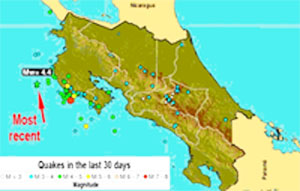 |
|---|
Map of New Earthquakes Since the Big One (in Red) In September of 2012. The Legend Says There Were Three (in Yellow) in the 5-6 Richter Range |
Over 300 aftershocks were reported in the 24 hour period following the big one on September 5. In the Nosara area residents have regularly been treated to aftershocks of the big one and also over 30 new sizeable earthquakes that occurred in September alone. This is thought to be the residual energy at the tectonic plates working itself out.
Since the Big One, many of the dozens of aftershocks have had epicenters in close proximity to Nosara. On Wednesday, October 10 alone there were four quakes
And remember, the scientists are saying there is much energy still left in the tectonic plate interface under the Nicoya Peninsula where the big one occurred. The energy has not yet been fully released say seismologists.
Volcanoes Changing Because of the Big One
The big Samara quake has had an effect on Costa Rica's volcanoes.
.jpg) |
|---|
Volcano Arenal on an Active Night |
Sometimes we forget that tectonic plates are penetrated in places where the earth's crust is thin, forming an exhaust funnel called a volcano. It's natural to expect, therefore (whenever you hear this from an engineer it means he has no proof or indicating data, just speculation), that a major change or energy release at the plates' interface where quakes occur, would cause changes in their brother volcanoes. I'm not a seismologist, but it's also easy to believe that the earth's energy released from a volcano relieves pressure on the plates and vice versa.
The other side of this incestuous relationship is that strong tremors can crack the thin crust under a volcano and produce eruptions. This connection has been observed over the years in Japan, Chile and Indonesia among others.
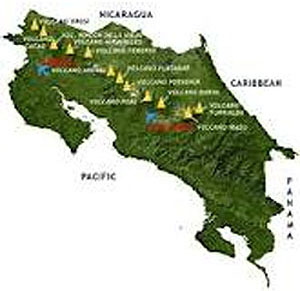 |
|---|
Note How the Major Volcanoes Run Right Down the Center Mountain Spine |
The National Seismological Network here (Red Seismológica Nacionál or RSN) noted that the Rincon de la Vieja volcano had a series of major magma eruptions in 1991, two weeks after the 7.7 magnitude earthquake at Limón. In 2009, the 6.2 Cinchona earthquake was followed by a small steam explosion (a phreatic release) from Poas Volcano four days later. "The volcano has remained in a state of recurring phreatic eruptions" said the RSN recently.
With regard to the current state of volcanoes after the Samara big one, seismologists have noted changes in their behavior ranging from increased phreatic eruptions to significant temperature changes in their plumes and accompanying lakes.
At Turrialba, east of San José there has been an increase in degassing activity and some rock slides along the slopes of the funnel (caldera). At Irazu, also east of San José, a number of earthquakes have occurred all around the volcano.
At Poas, northwest of SJ, the crater lake, called Laguna Caliente or "hot lake" has experienced increased up-welling of water and release of floating gobs of sulphur from a vent at the bottom of the lake where the temperature has reached 150 C (302 F - not a lake you'd want to swim in or drink from). A similar effect has been seen at Rincon de la Vieja. And at Arenal, the best known volcano in Costa Rica, more landslides have been observed.
So, when you live on the Pacific Rim, you can't think of what happened on September 5 as an "event", it's simply another episode in the continuing saga of earth's geological changes.
So there I was sitting on a chair under an umbrella on Manuel Antonio beach on Friday, October 12, over a month after the Big One. I was reading Atlas Shrugged when, suddenly, the atlas shrugged. Everybody on the beach felt the tremor and waved to each other smiling, but secretly I suspect that they just wanted reassurance that it wouldn't be more serious and that we'd stick together if it did.
It was a good shake to and fro but lasted only a few seconds, maybe three or four. It was a piece of candy compared to the September 5th Nicoya terremoto last month. It so happened that I was planning to leave por mi casa at that time and I joked with the life guards as I passed them to look out for the tsunami.
At th bus stop, one of the locals had a radio and reported, within 20 minutes of the event happening, that the RSN had measured a quake with a Richter value of 5.3 and that the epicenter was fixed at 25 kilometers southeast of Parrita. As the Richter scale is logarithmic, the 7.6 terremoto in September was about 120 times the energy release of the beach shaker.
If I’m not mistaken, the epicenter position quoted was about 30 yards from where I had my chair on the beach.
Spotted Skeeters
(A Nasty and Dangerous Pest)
The onset of the rainy season brings new greening of the Costa Rican countryside and an explosion of life in the jungle. Unfortunately, it also brings on the resurgence of flu and the dengue mosquito, a carrier of a debilitating virus which sometimes can be fatal.
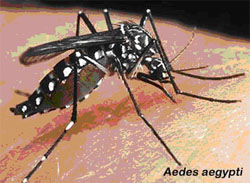 |
|---|
A Dengue (Aedes Aegypti ) Ready to Bite Into
It's next Victim |
 |
Typical Dengue Rash |
The dengue is one of over 3,000 mosquitoes in the world and one of the largest at up to 16 millimeters (0.6 inches) and weighing about 2.5 milligrams (< 0.1 ounces). That's a Body-Mass Index of 10 - very low, as compared to GG for instance. A distinguishing feature of the dengue is that it's dark brown to black body and is covered with white spots (see picture left).
If you see one of these dudes on your body, swipe it off, don't swat it - otherwise you might just drive it's dart and the venom into yourself.
There are four types of dengue fever (also known as breakbone fever), most of which are not fatal. Infection with one type usually gives lifelong immunity to that type, but only short-term immunity to the others. Subsequent infection with a different type increases the risk of severe complications.
In a small proportion of cases, the fever develops into a version called dengue hemorrhagic fever that causes bleeding, low platelet counts, and even dangerously low blood pressure. This version can be fatal. The other versions can also be life threatening to people with chronic diabetes or asthma.
The symptoms of dengue are fever, headache, muscle and joint pains. Taking aspirin can be dangerous if the hemorrhagic version is developed as it enhances the bleeding. The virus will also produce an extensive rash (see picture left). In addition, vomiting and diarrhea are common. The symptoms may take up to 14 days to appear after exposure (bite) to manifest themselves, so those that return home from a tropical and sub-tropical zone and exhibit fever in that time frame should have themselves checked out.
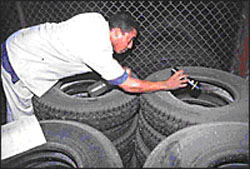 |
|---|
Checking Tires for Dengue Nests |
Like many mosquitoes, the dengue breeds best in pools of stagnant water, and since we live in the rainforest, these are not hard to find. There is a concerted effort here to drain public areas that might encourage dengues to reproduce but literally hundreds of these per square mile can be found in the wetter areas. Those non-natural things that gather water, such as old tires and open plastic buckets, are also frequented as dengue nests.
Unfortunately and unlike yellow fever, which can be carried by the same mosquito that causes dengue, the Aedes Aegypti, no vaccine has yet to be developed for dengue fever. Eliminating their habitats is the most successful method of avoiding infection and the subsequent need for treatment. Post infection treatment is rather basic and consists of assuring that the patient is well hydrated either through IV's or ingestion of liquids. Treatment with mild pain killers like aspirin (if the dengue is not the hemorrhagic version) is also indicated. Serious cases may include blood transfusions as part of the treatment.
Dengue is on the rise all over the world, aided in part by various conflicts and wars, particularly in Africa. Dengue mosquitoes can exist as far north (or south) as 35 degrees latitude and below 3,000 feet elevation making them a threat to much of the southern U.S. including the gulf coast (Sarasota, for example is 27 north and New orleans is 30). Quepos and much of Costa Rica is 9-10 degrees latitude.
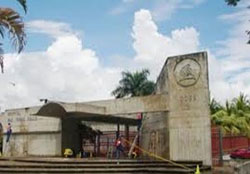 |
|---|
Hospital Max Terán Valls - Quepos |
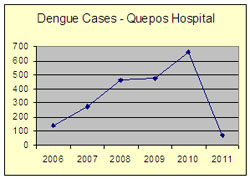 |
Dengue Cases in Quepos, Manuel Antonio 2006 to 2011 |
Through August of this year, some 8,480 cases of dengue fever have been reported in Costa Rica, a 36% rise over the same period in 2011. Part of that large increase results from 2011 being an unusually low year for dengue, so that the increase for 2012 looks larger than normal and 2012 is still significantly below 2010.
Quepos pretty much follows the national and world annual trends. The Quepos hospital has a large scorecard in it's main hall that shows, among other diseases, the number of cases of dengue fever treated each year. That data for the last six years is plotted on the graph below left. Note the steady increase in cases year to year, peaking in 2010 at almost 700 cases and then dropping in 2011 to only 69.
The year 2010 was a banner one for the disease. That year saw a total of almost 21,000 cases in Costa Rica and literally millions around the globe. In Costa Rica, in one particular week over 5,000 cases were reported.
So even at a 36% increase this year over last, Costa Rica is still not close to the levels of two years ago. Other parts of the world are doing much worse: The number if dengue cases reported in the Philippines, for example, in the first 8 months of 2012 was over 95,000 with 549 fatalities.
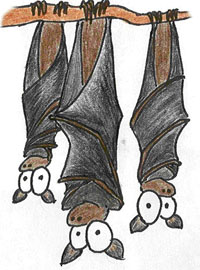 |
|---|
Been Hanging Around Quepos Hospital Too Much |
It's a good thing that dengue is not carried by bats. I say this because of a curious characteristic of our local hospital, the official name of which is Hospital Max Terán Valls. This hospital, except for the offices that are air conditioned for the workers, is open to the atmosphere.
Patient rooms have screens on doors and windows but common areas such as the main hall do not; those being open to the air flow from outside. The main hall has an atrium style ceiling and that's where the bats hang out, attaching themselves to the ceiling and sleeping during the day when the hospital is the most active. Heaven knows what they do at night but there are many fruit trees around the rainforest and they say these guys love fruit (and insects, which may explain why there are so few bugs in this open-air building).
GG runs out to the hospital a minimum of once per month to pick up my prescriptions, take a test ordered by the doctor or get my trimestral check-up. I always manage to take a bat count on the atrium ceiling. A few weeks ago I took a visiting friend, a nurse, with me so she could see the hospital, which she pronounced surprising in it's sophistication for such a remote area.
I tried to show her the bats in the belfry but they weren't to be found that day. Had the hospital finally found a way to discourage the little dudes from hanging around? Not really; on returning a couple of weeks later to get my medicines I was happy to report the bat count that day was 10. We were back to normal.
Look up amigos, watch the skies, count the bats and be aware of the spotted skeeters.
Durán, Durán
(Tales of Tuberculosis, Ghostly Nuns and Haggis)
It's not unrealistic to say that many people, perhaps most, are fascinated by ghost stories. Costa Rica has one such place with a paranormal reputation that's well known. It involves an abandoned building near Cartago, a town about 14 miles from San José. The place is called the Durán Sanatorium, named after Dr. Carlos Durán Cartin.
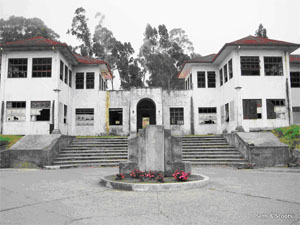 |
|---|
The Main Entrance to Durán Sanatorium |
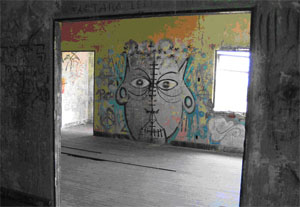 |
Part of the Walking Tour - That's Not an Apparition, Just Some Graffiti (or is it?) |
It was constructed in 1915 by the brave Dr. Durán to treat people with tuberculosis; a highly contagious disease which at the time had no cure. Dr. Durán's efforts were also motivated by the fact that his 15 year old daughter had the disease. Having contracted the disease at the sanatorium, she died there, contributing to both the mortality count and the paranormal interest.
The location, nestled in the foothills of the central valley mountains, was considered ideal for treatment and recovery as that area has a temperate climate, low humidity, lots of fresh breezes and sun. (If only it had a beach). It is also away from the population centers, which would help to minimize infection. At it's height, Durán had over 300 beds, several doctors and a number of nuns (Sisters of Charity of St. Anne) on it's staff
Durán has been many things in its past, not all of them pleasant. When modern medicine caused tuberculosis to decline, the building subsequently was used as a hospital for women and children, an orphanage, a prison and a mental asylum. It was permanently abandoned in 1973 after being severely damaged by the eruption of the nearby Irazu volcano.
Visitors report strange things happening when they walk the halls of Durán. They range from mysterious whispers to the instantaneous drainage of a fully-charged video camera battery. There also has been a variety of apparitions. Among the most frequent sitings are that of a nun plying the halls presumably running her duties and errands as a caretaker, a woman with white hair wearing a blue dress and a young girl presumed to be Dr. Durán's daughter.
Durán has been checked out by investigators from Ghost Hunter's International. This paranormal investigative group visited Durán with various sound and light sensitive recorders and other devices. They were treated to whispers that they recorded, one of which was an apparition clearly saying "help". They also recorded a mysterious light that appeared and then disappeared in a short succession of photographs as well as the outline of a little girl sitting in a corner.
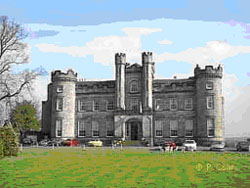 |
|---|
| Airth Castle in the Daytime |
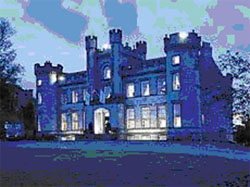 |
Airth Castle at Night Room 20 is Top of the Right Tower |
Researching the history of Durán resurrected an experience our hero had back in 1973 in Grangemouth, Scotland, an industrial area about 40 miles northwest of Edinburgh. I had made several business trips there over a three year period and, at the suggestion of colleagues, stayed at a small hotel called the Airth Castle located in Falkirk, only about 10 miles from Grangemouth. Airth is situated in the heather-laden countryside that is so beautiful in Scotland in the spring and summer.
Airth is a real castle with a (dry) moat and the Airths were a real family, descended from the Picts, many of them having been buried in the family plot next to the castle. The castle, the original construction of which goes back to the 14th century, was subject to the intrigues of many Scottish and English dukes, earls and barons who vied for political power and religious dominance in northern Britain.
I think it was on my third visit that it happened. I had been given Room 20, the best in this 20-room hotel. It was situated at the top (3rd floor) of the right turret of the castle as shown on the picture to the right. As I recall, there was no elevator and one had to march up a wide, rounding stairway to the third floor to reach the room. I noticed that the stairway wound around what appeared to be another, narrower turret centered at the core of the larger one.
When we reached the top, I saw a door in the inner turret. I asked the porter, who had brought my bags up the three flights, what was behind the door. He opened it and showed me a very tightly spiraled staircase leading down into the darkness. "No light in there, suh". (No laddie, I can see that on me own.)
I asked him what the purpose of the staircase was and he said the stairs led down to a tunnel below the main floor of the castle. The tunnel, in turn, led under the moat and surfaced at a vegetable cellar some 50 yards from the castle. The main purpose of the whole thing was to provide a means of escape from the castle if anyone threatened the castle and the family.
 |
|---|
| Earl Fergus Airth - "Woot arr ya doin' in me room. laddie?" |
The porter closed the inner turret door and latched it. He turned and opened my room door, which was only about five feet from the escape turret. The guest room itself was round and provided excellent views of the Scottish countryside.
After settling in, I met some colleagues in the hotel dining room for dinner. I remember that it was my first and only experience with haggis, that Scottish specialty cooked in a pig's stomach and made out of livestock parts that shouldn't be mentioned in polite company.
Fortunately, as always, there was a good wine to neutralize the haggis and ample Glennfiddich malt scotch which we drank as a brandy after the meal. I retired by eleven and noticed as I entered the room that the inner turret door was still locked and latched.
About three in the morning I awoke suddenly. There was a very intense static electricity crackling in the room that felt like a presence, but I saw no apparitions or even outlines of people. After a few minutes I got up, walked to the door and opened it, standing there in my static charged underwear.
The door to the inner turret had been flung wide open and all I could see was the staircase leading down to the basement. I returned to the room and after a few minutes, the static electricity subsided. After a while I was able to go back to sleep.
Was it the haggis? The Glenfiddich? I doubt it was overeating and drinking as I was strongly embracing that lifestyle during that period and never had such a reaction elsewhere. Over-indulging was not new to me (I was in my early 30's and capable of bouncing back quickly) and repeated behavior like that in many places around Europe never produced anything remotely similar to that experience.
So what was it? Perhaps it was Fergus Airth. an ancient Earl of Falkirk, suggesting I get the hell out of his bedroom. I guess I'll never know, at least on this side of the Great Moat.
Boo!
Pay The Penguin On The Way Out
(How to Embarrass a Debtor, Latino Style)
Speaking of fearful situations, if you have ever been in a position of being unable to pay a debt, then you know how uneasy and nervous you can become.
In the States, debt collection is usually handled through a barrage of mail notices and unexpected telephone calls or perhaps an occasional visit to the door if the debt is large enough and/or grossly overdue. By and large though, the process is rather private and handled quietly (at least before the courts get involved). Having gone through one bankruptcy in the U.S. about 20 years ago, I know how persistent some agencies and their representatives can be until the court says stop..
 |
|---|
Helpful Debt Handling Suggestions |
One year, in the ten year history of one business I owned, things were particularly difficult. We were paying our debts, but too slowly, and the constant juggling of who's going to get the next payment was nerve-racking. But in the midst of our difficulty, I mentioned the problem to a collared deacon friend in our church, in confidence and only with the hope of getting some spiritual guidance.
I came to know later that this deacon's Italian family name was well known in Philadelphia among the "made men". On one occasion he rushed out of the parish office saying he had to go to Philadelphia because one of his uncles had put out a contract on another of his uncles and he had to get it cancelled!
A week or so after mentioning my plight to the deacon, while sitting in my office, I got a call from a stranger with a very Italian sounding name who said he was based in Philadelphia (south Philadelphia, of course). "Yo, mista Normand, I have been apprised dat youse might need some funding and I am happy to report dat I am in a position to help." I talked with him politely for a few minutes but eventually, and very politely declined his offer. I also waited until he hung up first to be sure it wasn't I who hung up on him.
I had visions of somebody named Vinny Three-Fingers Gatouchi showing up on my doorstep to collect the monthly payment. We eventually worked our way out of this difficult period without any outside help and even had some banner years thereafter.
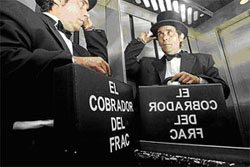 |
|---|
A Pinguino Prepping Himself for a Visit.
No Doubt About What He's Doing,
Carrying That Briefcase |
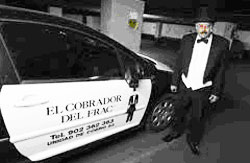 |
Recently I came across another way to practice debt collection, a very latino and gentler way. This practice is not common in Costa Rica at this time but it is widely used in Spain and Colombia.
The debt collectors in these places are officially called Los Cobradores del Frac but they are better known as Los Pinguinos or the penguins. They got their nickname from their unusual dressing habit; they show up in formal tux with tails and top hat. As if that's not enough, they drive black cars with large white signs on the doors that proclaim who they are.
With that kind of entry, there is no doubt to either you or your neighbors who's calling and what they want. I suspect that in many cases just their appearance is enough to produce a payment by virtue of embarrassment.
Although it is self-evident that a man in a formal tux might be likened to a penguin, I was surprised that someone in Colombia, being even farther south than Costa Rica and only 4 degrees above the equator, would have picked that bird as a model. The only penguins in Costa Rica are in the zoos. After all, penguins are creatures of cold like in the Arctic and Antarctic, right?
Wrong, oh unknowledgeable golden one. As it turns out. there are three species of penguin native to Colombia: the Humboldt, the Magellanic and the Galapagos penguins. See photos below.
 |
 |
 |
|---|---|---|
The Three Penguins of Colombia - the Humbolt, the Magellanic and the Galapagos |
||
So, if you see Pinguinos at the door better hope they're quacking and not carrying brief cases.
What's-in-a-Word
Hongos (on - goes)
This word is commonly used to describe mushrooms.
So I was a bit surprised when I went shopping the other day at the supermarket for some bathroom cleaner to find a product by Mr. Musculo, Costa Rica's answer to Mr.Clean, that one of the claims on the label was that the product was "anti-hongos". Now I haven't bought many cleaning supplies here because the deal I have with the landlady is that she supplies the cleaning lady and that lady, by the name of Hortencia and as sweet a person as they come, usually brings her own supplies. But this time Hortencia asked me to pick up some cleaner so I did. She does such a great job, I was more than happy to comply.
It took me a little while but with the aid of a Spanish/English dictionary and remembering a bit of high school biology, the connection became obvious: a mushroom is a fungus. A bathroom cleaner that is "anti-hongos" is anti-fungus. I bought a large bottle of Mr. Musculo "anti-hongos" spray for Mrs. H.
So now my bathroom tiles are spotless and completely mushroom free. No hongos here Hortencia.
Tepezcuintle (teh - pes - quint - lay)
One evening recently I was taking out the trash after dinner when I was stopped by my landlady and her oldest son. At the bidding of his mom, Brian asked if I wanted some tepezcuintle. Some what, says I?
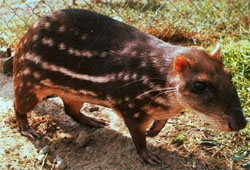 |
|---|
A Tepezcuintle - Cute Little Rat, Isn't It? That is, If You Can Consider a 20 Pound Rat "Cute" |
In the remote foothills and mountains of Mexico, Central America (including Costa Rica) and parts of South America lives an oversized rodent called a tepezcuintle. It also goes by the names of Lowland Paca or Spotted Paca. This not-so-little fella ranges in weight from 6 to 12 kg (13 to 26 pounds) and is much prized by the natives for it's rich tasting meat. It's also considered a pest by many farmers as it has a penchant for destroying crops like avocados, mangos and sapotes (sapotes are yet another tropical fruit found here)..
Although the numbers of said rodents have declined significantly with population increases over the decades they are still relatively easy to find in remote areas, and even prolific in protected areas. With a gestation period of about 120 days, females can give birth to one or two babies per litter, twice per year. But the public demand outstrips the supply and the two kilo chunk, bone in, that my landlady bought was 20,000 colones or about $9 per pound. That's not chopped liver, baby, particularly in Costa Rica..
I was pleasantly surprised at the taste of the tepezcuintle given me to sample. It was accompanied by some chimichurri (much like a salsa) and half a boiled plantain. Chimichurri has a great, slightly piquant taste that offsets meat very well. Boiled plantains don't do anything for me, they're like a hard tasteless banana, but fried soft in butter they're yummy.
The flavor of the tepez was truly unique, not chicken, not beef, not pork and a bit richer than all three.
So now I can say I've sampled a true Costa Rican delicacy - mountain rat. Damn good, too.
ROMEO Corner
(Retired Old Men Eating Out)
Salt - Manuel Antonio
This restaurant is now known as "Z"; go here: Restaurant "Z"
Location: In the Plaza Yaro, Main Road Manuel Antonio, Half Way Between Hotel Mono Azul and
Hotel Gaia (Wouldn't it be Nice to Have Addresses?)
Hours: 2-10 PM, Monday thru Sunday
Parking: Ample, Directly in Front of the Restaurant.
Contact: Tel.: 27 77 69 48; Fax: N/A; Email: N/A; Website: N/A
Reviewing ROMEOS: Anita M., John S.. David H., Bob N., Visiting ROMEOS: Kay, Jenny.
To Review Our Rating System and Procedure, go here: R.O.M.E.O. Rating System
We were very happy to welcome Anita M. as a new ROMEO (our title is the only thing sexist about us). Anita is a long time resident of the area and provided us with interesting anecdotes about the region.
Salt is a new eating emporium located in the same space as the former La Hacienda restaurant. Our group arrived about 7 PM and became the only party in the place; this is, after all, the heart of the slow season.
The place is very plain or "tipico" for the area in the sense that the tables and chairs are plain local hardwood and contained, like the walls, no adornment or decorations other than a small candle. The lighting was pleasant for eating and conversation but more difficult for reading the menu, however the one page menu was fairly easy to read and contains an interesting assortment of appetizers, including gazpacho, a calamari dish with three sauces and mussels. In addition there is a set of salads, sandwiches and seafood dishes.
With regard to the appetizers, the gazpacho was nice and cold and tasty, just slightly spiced but would have been even better had it contained a sprinkling of finely chopped cucumber, tomato and sweet pepper like the original Spanish recipe The mussels were tender and in a savory sauce. The lightly breaded and fried calamari and fish fingers were very tasty. For main courses, two of us tried the filet mignon, one had red snapper and another had a linguini combination while still another had a chicken sandwich. All the food was very well presented and colorful. The filets were tasty and medium tender, a better tenderness than typical beef in the area but not top notch. The fish and chicken sandwich were reported to be good also. We all declined desert as the offering was very limited and we were pleasantly full. |
 |
|---|---|
$ $ $ $ |
Our waiter, a young tico gent was very gentle, considerate and attentive. The delivery from the kitchen of the main courses was slow and entrees were delivered with as much as ten minutes passing between service to different persons. We attributed this somewhat to the limited chef coverage in the kitchen because it was slow season.
One surprise of the evening came when the check arrived as one of the ROMEOS learned that the restaurant does not accept credit cards. This can be an inconvenience when most diners would expect card processing capability in a restaurant of this purported caliber.
For ambiance, food quality and service we give Salt an overall rating of three and a half sloths sloths, largely on the basis of the above average food quality. The rating would have been four if not for the uneven kitchen service and the credit card problem.
The cost for two courses with soft drinks ranged from $25-35. One ROMEO who had three courses including the filet came in at about $44. This puts Salt into the top 20% of restaurants in the area for cost. We give it a cost rating of four dollars.
Overall, it was a pleasant dining experience, if a little rough at the edges on kitchen service, payment terms and being a bit pricey.
don Beto de Quepos, El Gringo Dorado Pura Vida! |
Be pithy but kind. I'm sensitive. |
|---|
